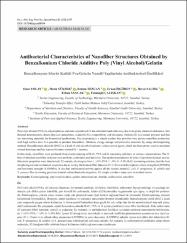Antibacterial Characteristics of Nanofiber Structures Obtained by Benzalkonium Chloride Additive Poly (Vinyl Alcohol)/Gelatin

View/
Access
info:eu-repo/semantics/openAccessDate
2019Author
Yolay, OnurYüksek, Metin
Tezcan, Erdem
İşgören, Erkan
Saltık, Derya
Sancak, Erhan
Çalışkan, Fatmagül
Metadata
Show full item recordCitation
YOLAY, Onur, Metin YÜKSEK, Erdem TEZCAN, Erkan İŞGÖREN, Derya SALTIK, Erhan SANCAK & Fatmagül ÇALIŞKAN. "Antibacterial Characteristics of Nanofiber Structures Obtained by Benzalkonium Chloride Additive Poly (Vinyl Alcohol)/Gelatin". International Journal of Advances in Engineering and Pure Sciences, 31.2 (2019): 122-127.Abstract
Polyvinyl alcohol (PVA) is a hydrophilous and semi-crystallized. It has attracted much relevancy due to its pretty chemical endurance, fine
thermal determination, decent physical specialities, wonderful bio-compatibility and cheapness. Gelatin (G) is a natural polymer and that
are interesting materials for biomedical applications. Electrospinning is a simple method that provides very porous nanofiber production
with high surface area. It is possible to produce biomedical, filtration, energy storage and protective materials by using electrospinning
method. Benzalkonium chloride (BAC) is a kind of anti-microbial cationic surface-active agent, which has been pretty used in merchant
wound dressings and has a powerful status toward Gr+ bacteria.
In this study, nanofibers were produced from electrospinning of BAC, PVA and G containing solutions at various concentrations. The fibers
of obtained nanofiber structure were uniform, continuous and intensive. The optimum parameters in terms of good mechanical and antibacterial
properties were determined. S2 sample, electrospun from 11.63% PVA + 1.0% G +1.0% BAC containing solution, had the best
morphological and mechanical properties due to having the thinnest fiber diameter (51±13nm) and the highest vertical strength (4.299MPa)
and horizontal strength (4.058MPa). It also had antibacterial activity against all the bacteria tested (E. coli, P. aeruginosa, B. subtilis and
S. aureus). Due to owning good mechanical and antibacterial properties, S2 sample can have many uses in medical sector. Poli (vinil alkol) (PVA), iyi kimyasal dayanımı, iyi termal kararlılığı, iyi fiziksel özellikleri, mükemmel biyouyumluluğu ve ucuzluğu nedeniyle
çok dikkat çeken hidrofilik, yarı kristalli bir polimerdir. Jelatin (G) biyomedikal uygulamalar için ilginç ve doğal bir polimerdir.
Elektroeğirme, yüksek yüzey alanına sahip çok gözenekli nano elyaf üretimi sağlayan basit bir yöntemdir. Elektrospinning yöntemi
kullanılarak biyomedikal, filtrasyon, enerji depolama ve koruyucu malzemeler üretmek mümkündür. Benzalkonyum klorür (BAC), ticari
yara sargısında yaygın olarak kullanılan ve Gram-pozitif bakterilere karşı güçlü bir role sahip olan bir tür antimikrobiyal katyonik yüzey
aktif malzemedir. Bu çalışmada, çeşitli konsantrasyonlarda BAC, PVA ve G içeren çözeltilerin nano lifler üretilmiştir. Elde edilen nano
lif yapısının lifleri homojen, sürekli ve yoğundur. İyi mekanik ve antibakteriyel özellikler açısından optimum parametreler belirlenmiştir.
11.63% PVA + 1.0% G +1.0% BAC içeren S2 örneği en iyi morfolojik ve mekanik özellikler göstermesinin yanında en ince elyaf çapına
(51 ± 13nm) ve en yüksek dikey dayanıma (4.299MPa) ve yatay dayanıma (4.058MPa) sahiptir. Ayrıca test edilen tüm bakterilere (E.
coli, P. aeruginosa, B. subtilis ve S. aureus) karşı antibakteriyel aktiviteye sahiptir. İyi mekanik ve antibakteriyel özelliklere sahip olması
nedeniyle, S2 örneğinin tıbbi sektörde birçok kullanımı olabileceği sonucuna ulaşılmıştır.


















